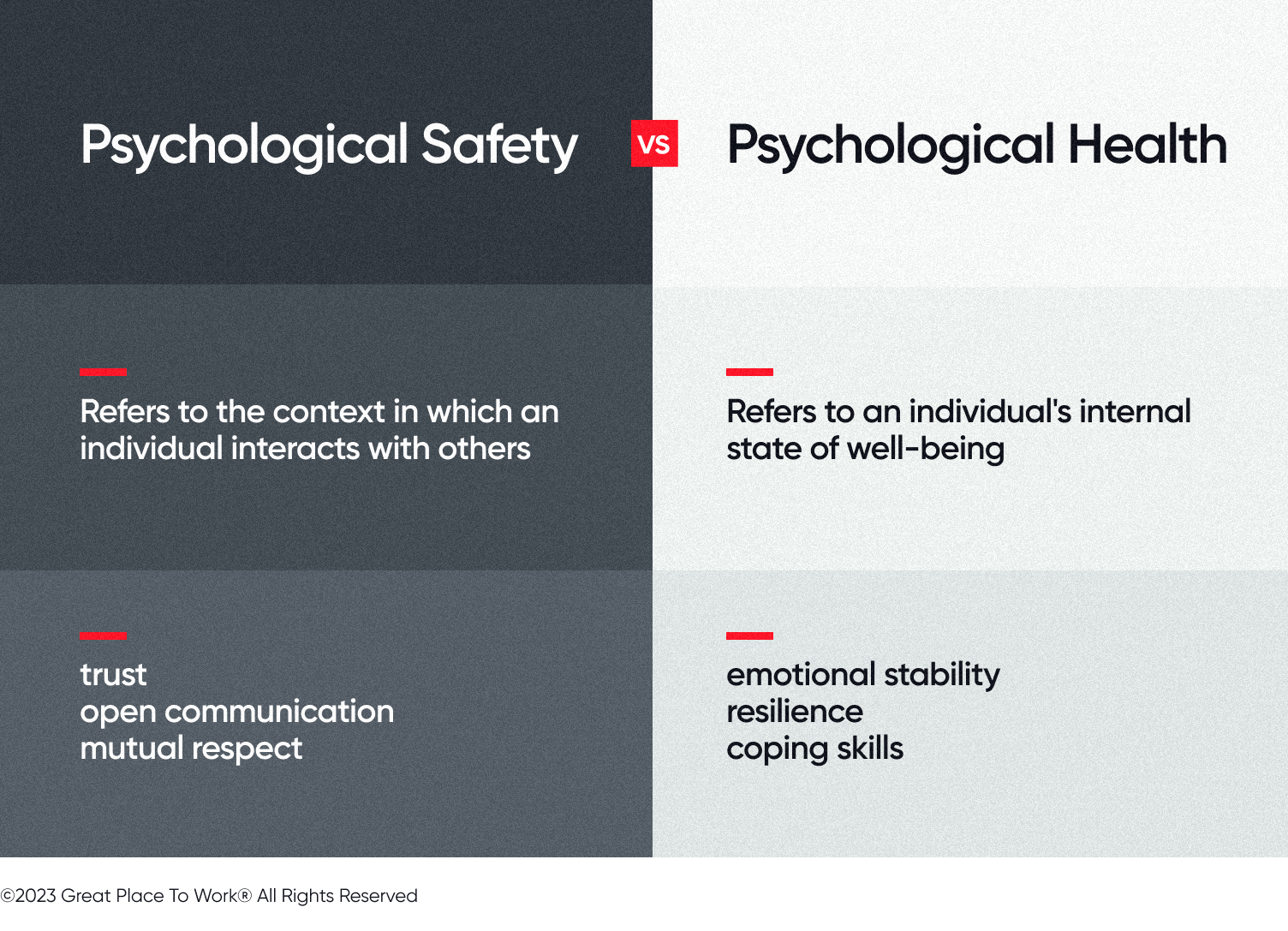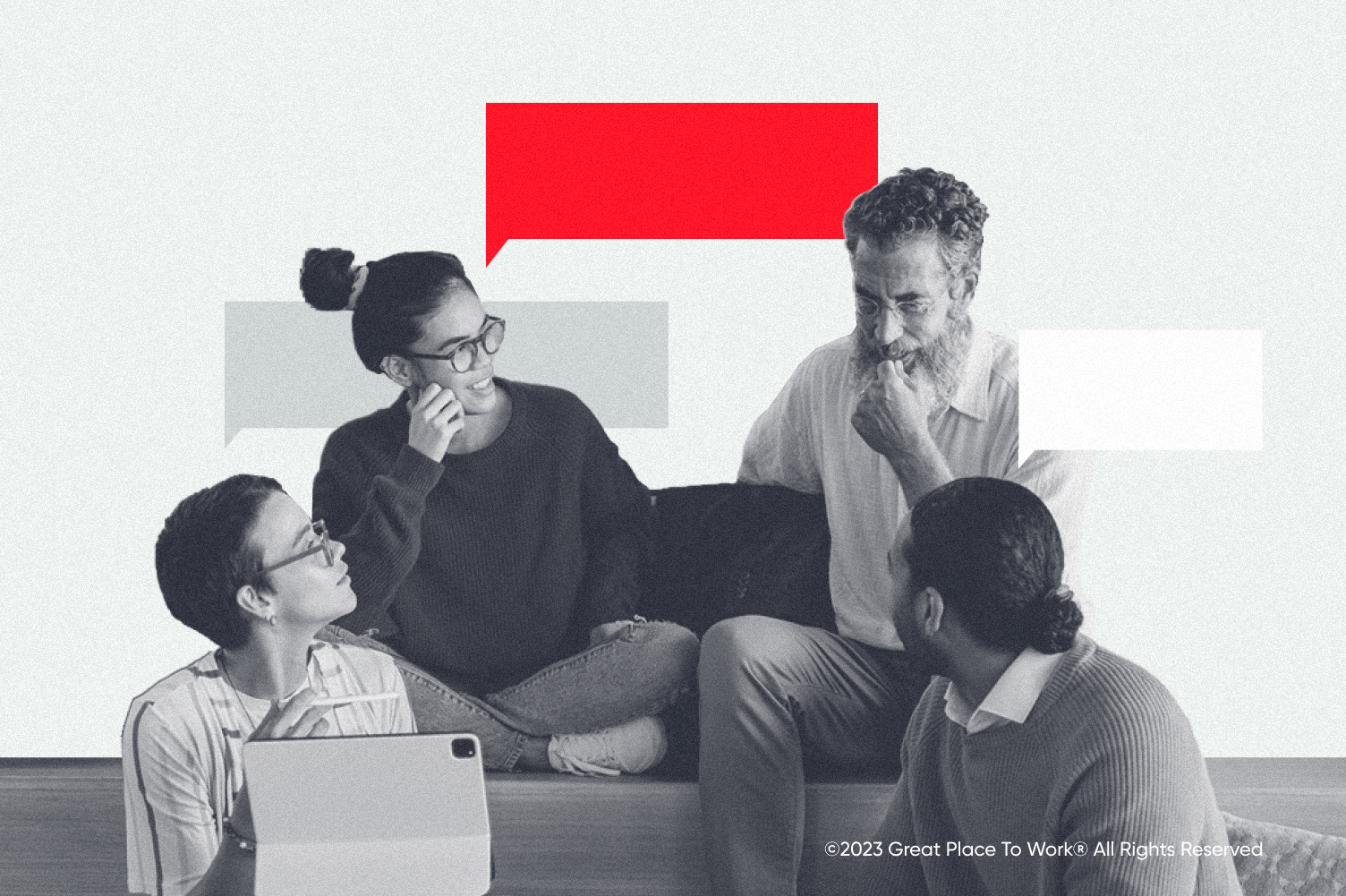Diversity & Inclusion, Employee Experience, Employee Well-being, Psychological Safety
Psychological safety is often misunderstood and undervalued in the workplace. When leaders cultivate a psychologically safe workplace, employees are more engaged and far more likely to bring forward game-changing ideas.
I once was in charge of running the social media channels for the company I worked for. When I shared a post to the company’s Instagram channel, one of my colleagues would often make a sarcastic remark or roll their eyes. They would comment on little details, from the choice of words to the choice of images.
Their constant criticism made me feel anxious and self-conscious about my work. I started questioning whether I was doing a good job. I second-guessed every post, trying to anticipate every possible criticism and making sure everything was perfect. I felt paralyzed by the fear of making a typo or facing more snide comments.
As these small criticisms accumulated, I increasingly felt like I couldn't take any risks or be creative in my work. I was so afraid of being criticized or judged that I started playing it safe, putting up bland and uninspired posts that wouldn't draw attention or invite any criticism. The more my psychological safety eroded, the more my work suffered.
What do we mean by psychological safety?
Psychological safety refers to the feeling of being able to speak up, take risks, and make mistakes without fear of negative consequences.
The term psychological safety was first coined by Amy Edmondson, a professor at Harvard Business School. She described it as “a shared belief held by members of a team that the team is safe for interpersonal risk-taking.”
In 1999, while studying the rate of mistakes made by medical teams, Edmondson found that the teams that made more mistakes performed better than teams that made fewer mistakes — or at least, that’s how it seemed at first. Rather, it was the teams that had a culture of openly admitting to making mistakes that had better outcomes. The other teams were making mistakes, too; they just hid them.
Simon Sinek later wrote about psychological safety in the workplace in his 2014 book “Leaders Eat Last.” Inspired by military organizations, where leaders literally put their lives on the line, he wrote that great leadership is about making employees feel safe so they can focus on work without fear for their own survival.
Why psychological safety matters in the workplace
Psychological safety isn’t merely a nice to have — it’s essential for a business to operate efficiently and effectively. Without it, employees won’t trust their employer, and the whole business can suffer.
“If you think about it from the business perspective, when people feel psychologically safe in the organization — are able to share ideas, questions, concerns — the company is more agile,” says Julian Lute, senior manager and strategic advisor with Great Place To Work®.
“We’ve seen through our research on psychological safety that when people question their every move, when people aren’t sure if they should raise questions, initiatives and programs roll out very slowly.”
A lack of psychological safety can thwart new projects, processes, and procedures. Without it, employees fear anything from being criticized if they can’t keep pace, to being made redundant because of new, “better” initiatives.
But creating psychological safety goes beyond just encouraging people to speak up. It also includes how an employer views work/life balance.
“Great leadership is about making employees feel safe so they can focus on work without fear for their own survival.”
“Psychological safety allows people to bring their full selves,” says Julian. “It allows you to show up in a way that’s much more authentic. The company is looking out for you. You’re not just a cog in the machine, and they care about your long-term success. And then the benefit that the company gets is that employees actually care about the success of the organization.”
Psychological safety vs. psychological health
Feeling psychologically safe is not the same thing as feeling psychologically healthy, although the two are closely related, says Marcus Erb, vice president of data science & innovation at Great Place To Work.
Psychological health refers to an individual's overall well-being and mental state, he explains. It encompasses a range of factors, such as emotional regulation, self-esteem, resilience, and the ability to cope with stress and adversity.
“Psychological safety is one component of a psychologically healthy workplace, where employees feel supported and empowered to express their opinions and ideas without fear of retribution,” he says.
“A psychologically safe workplace can contribute to better psychological health, as employees who feel safe and supported are more likely to experience less stress and anxiety and have better overall employee well-being.”
While psychological safety and psychological health are related, they are not interchangeable. Psychological safety refers to the context in which an individual interacts with others, while psychological health refers to the individual's internal state of well-being. Both are important factors in creating a positive and supportive work environment that promotes overall well-being and success.

6 signs your workplace is psychologically unsafe
If you’re unsure whether your company is creating a psychologically safe work environment (and there’s no obvious factor like my belittling manager), there are a few red flags to watch out for, says Julian:
1. Projects take too long to roll out
Agility suffers when a workplace is psychologically unsafe. Employees are suspicious of new processes and procedures and may even work around them rather than give feedback. When psychological safety is low, instead of asking for help or clarification, employees would rather keep quiet and soldier on in uncertainty.
2. People don’t ask questions or share ideas
In meetings, few people (or no people) speak up or contribute. Ideas are presented in a top-down manner, with little room to question decisions or raise concerns. If an employee felt like their ideas were valued, they’re less likely to internally label something a “dumb idea” or hesitate to bring new ideas up in a meeting.
3. The rumor mill is rampant
Rather than address issues openly, employees air their grievances within cliques or other teams. There is mystery and speculation about why or how a new initiative will happen.
4. High absenteeism
Employees may take unplanned leave or call in sick to avoid a micromanaging boss, microaggressions in the workplace or intense pressure on the job, even if they are not physically ill. The lack of psychological safety can create a culture of disengagement, where employees are not motivated to come to work, leading to increased absenteeism.
5. High presenteeism
Presenteeism refers to the phenomenon of employees coming to work even when they are sick, injured, or otherwise unwell, and not fully engaged in their work.
Digital presenteeism is a phenomenon where employees feel pressured to constantly remain connected to their work through digital devices, like checking and responding to emails, in an effort to appear to be working hard and often.
Presenteeism can be a sign of low psychological safety in the workplace because it indicates that employees do not feel comfortable taking time off when they need it and are struggling to perform at their best.
6. High turnover
Employees are simply leaving. Without a voice, they leave for roles elsewhere that encourage more open discourse.
How to foster psychological safety in the workplace
Writer Dr. Timothy Clark identified four stages of psychological safety:
- Inclusion safety — You are welcome into the organization as your authentic self.
- Learner safety — You are free to ask questions and make mistakes while you learn.
- Contributor safety — You are encouraged to share your ideas without fear of retribution.
- Challenger safety — You are safe to question the status quo, raise concerns, and provide dissenting opinions without fear of negative consequences.
All these stages apply to the workplace, and employees may move back and forth in the stages as new projects are rolled out or they change teams or roles. Here are five ways that managers can ensure psychological safety at every stage:
1. Be vulnerable
Leaders are human, too. A manager who admits to making mistakes or to not having all the right answers will create a far more psychologically safe workplace than a manager who hides their flaws or pretends to know it all.
At Ryan LLC, a tax services and software provider, mandated training sessions address well-being, psychological safety, failure tolerance and setting boundaries. To demonstrate vulnerability, the training includes leaders sharing their own stories of failure, and participants are encouraged to share their experiences of being on teams that got things done versus teams that didn’t.
Julian, too, says he has witnessed first-hand how powerful this can be while he was working with an organization that demonstrated high psychological safety.
“The company was rolling out this strategy for go-to-market with customers,” explains Julian. “And there were some big questions. When we got to our meeting to talk about it, our leader said, ‘I’m acknowledging there are some holes in the plan. We don’t have all the answers right now.’”
He says that simple display of vulnerability opened the door for employees to raise other concerns, resulting in a far more effective problem-solving session.
2. Be transparent
“Sharing what you know is good, but what’s better is sharing what you don’t know. And best is sharing information transparently: what you know, what you don’t know, and how you’re going to help people get through it,” says Julian.
Communication that is open, honest, and credible feeds into psychological safety. Communicate consistently and directly, and make sure your actions match your words.
3. Be fair
Review every aspect of the employee experience and assess its fairness. What are the pathways to promotion? Are there pay gaps among any equivalent roles? Are people compensated and rewarded fairly?
Fairness can be an especially thorny issue with hybrid teams, where employees who are primarily remote may feel that they’re often overlooked due to a lack of “face time.” Ensure that they feel heard and supported as equal members of the team.
“Sharing what you know is good, but what’s better is sharing what you don’t know. And best is sharing information transparently."
4. Be curious
Strong leaders model curiosity — they ask questions and don’t necessarily assume the status quo is the right way. Acknowledge any uncertainties and foster a company culture of learning and problem-solving rather than blind following.
For example, the team at SAP America, an IT company based in Newtown Square, Pennsylvania, acknowledges that psychological safety must begin at the top. Their new leadership credo, “Do what’s right. Make SAP better for generations to come” asks company leaders to think about the long-term impact of their actions and decisions.
“It is a clear signal that SAP’s leadership culture is moving away from one where leaders feel they need to make short-sighted decisions to make quarterly numbers, and toward a trust-based and ethical environment where teams have the space to be themselves, learn, grow, and thrive,” an SAP team member told us.
SAP’s leadership diverges from a company culture where leaders feel they need to make short-sighted decisions to make quarterly numbers. Instead, they move toward a trust-based and ethical environment where teams have the space to be themselves, learn, grow, and thrive.
5. Be reasonable
Unrealistic expectations — whether that’s how much someone can accomplish in a day or how available they need to be last-minute — can kill psychological safety.
Julian notes this is especially an issue for hourly workers who have less flexible schedules or schedules that are only set two weeks or so in advance, such as retail and hospitality workers. He warns that when people have a week-to-week schedule, they can’t manage work/life balance and, as a result, can’t feel like they fit in with the organization.
This can also be an issue for remote or hybrid teams, especially when they cross time zones and employees may be working while management is sleeping, or vice versa. Show that you respect employees’ personal lives and that you trust them to get their work done, even when out of sight.
How to measure psychological safety in the workplace
Conducting employee surveys on a regular basis will ensure you keep your finger on the pulse of how psychologically safe employees are feeling. Great Place To Work’s precise and rigorously tested Trust Index™ Survey statements are specifically designed to elicit meaningful employee feedback and insights.
To learn more about the psychology of high-trust workplaces, subscribe to our newsletter or inquire about Great Place To Work Certification™, which can help you to measure and understand how psychologically safe your employees feel.














